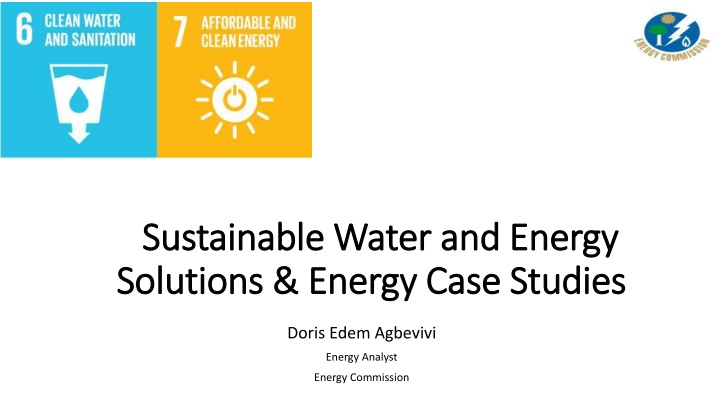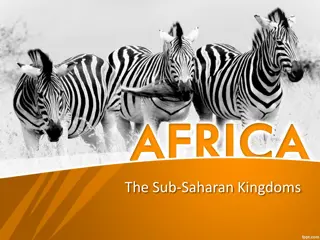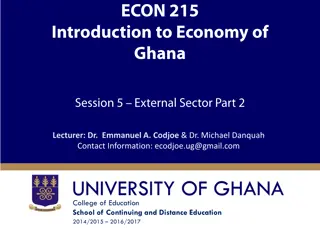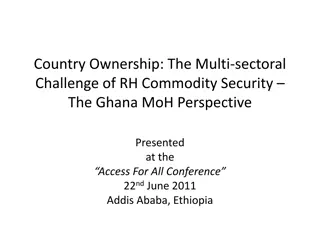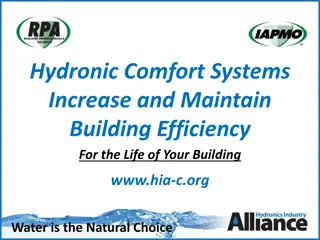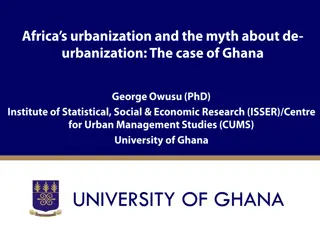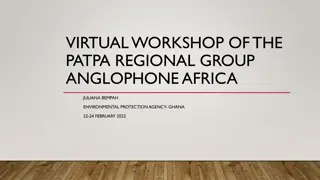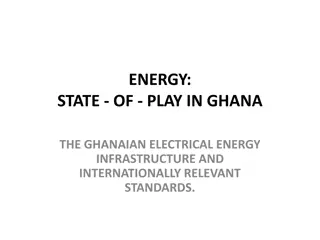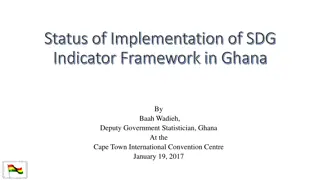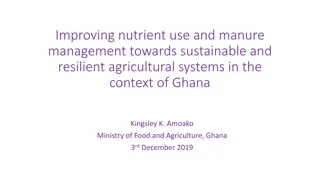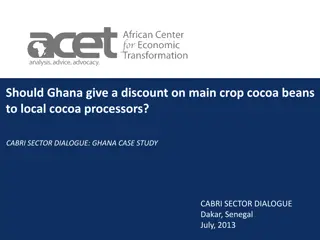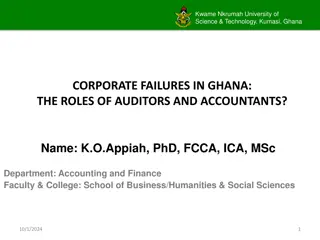Sustainable Water and Energy Solutions in Ghana
Ghana has made significant progress in electricity access and water coverage through initiatives like the National Electrification Programme and ground water technologies. Case studies such as the Bui Power Plant and the Lawra solar power plant showcase the country's commitment to renewable energy solutions for water production and treatment.
Download Presentation

Please find below an Image/Link to download the presentation.
The content on the website is provided AS IS for your information and personal use only. It may not be sold, licensed, or shared on other websites without obtaining consent from the author.If you encounter any issues during the download, it is possible that the publisher has removed the file from their server.
You are allowed to download the files provided on this website for personal or commercial use, subject to the condition that they are used lawfully. All files are the property of their respective owners.
The content on the website is provided AS IS for your information and personal use only. It may not be sold, licensed, or shared on other websites without obtaining consent from the author.
E N D
Presentation Transcript
Sustainable Water and Energy Sustainable Water and Energy Solutions & Energy Case Studies Solutions & Energy Case Studies Doris Edem Agbevivi Energy Analyst Energy Commission
WHERE DO WE STAND? WHERE DO WE STAND? Ghana Energy access 87% (2021) Large-scale and small-scale grid connections Off-grid solar installations ( three solar powered mini-grid, capacity of 50kVA, would deliver green and sustainable electricity to about 300 households ) In 1988, the government collaborated with the utilities to connect all of the regions and districts in the country through the National Electrification Programme In 1989, the government established the National Electrification Fund and the Self-Help Electrification Programme (SHEP), which offered to connect communities within 20 km of the existing grid.
Electricity Access in Ghana 87 85.3 85 84.3 84.1 83.6 83.2 80.5 70.8 64.4 1 2010 2013 2014 2015 2016 2017 2018 2019 2020 2021
WHERE DO WE STAND? WHERE DO WE STAND? Access to Water 81% (2017) significant improvement in water coverage since 1990 MDG target of 77% drinking water coverage was achieved in 2008 groundwater technologies boreholes, hand-dug wells community pipe systems Through separate initiatives
Case Studies Case Studies- - Bui Power Plant Bui Power Plant 400 MW Generating Station 5MWp Floating Solar on the reservoir
Case Studies Case Studies The need to produce water as well as treat it depends on renewable energy in water production and treatment to bring down cost Achieving safe treatment of waste water and energy preferably renewable energy options Safi Sana is a Dutch business that builds systems for generating energy from biological waste
Solar Solar- -powered Water Facilities powered Water Facilities VRA built solar powered water facility for the people of Volo in the North Tongu District of Ghana
Solar programs Solar programs 2018 rollout of a national rooftop solar program aiming to install 200 MW of rooftop solar across the country. A total of 1083 confirmed installations in the urban areas and rural off-grid households
Success Stories Success Stories Some local Ghanaian projects that leverage energy-water include solar-powered water pumps as an alternative to piped water Agriculture accounted for 80% of withdrawals in SSA Oxfam s solar energy pilot project in Kpatua, Ghana - a new well is powered by 10 solar panels that can generate 1,800 watts. - 10 households, primary school and clinic have access to renewable energy. - solar lamps distributed to 100 households. - Solar Irrigation for farming in almost every region in the country some privately funded while others
Success Stories Success Stories ENI signed an MOU with the VRA aimed at developing solar energy projects on the Volta Lake through the deployment of floating solar energy technologies Construction of the Pwalugu Multipurpose power plant comprising 60MW hydro power hybridized with a 50MW solar plant by the VRA has also commenced. 45Kw micro-hydropower plant known as Tsatsadu Generating Station (TGS) Recent amendment bill to the Renewable Energy Act was passed in parliament in November
Key Challenges facing policy makers who aim to create an Key Challenges facing policy makers who aim to create an enabling environment for Investments and innovation enabling environment for Investments and innovation Poor coordination of policies and decisions and sectors working in silos Uncertainty in water investment, investment priorities and sustainable development Challenging investment climate Perceived risk by financial sector Financing terms and high commercial interest rates High inflation Currency depreciation Uncertainty around pricing of renewables technologies elevates perceived risk factor Limited availability of experienced personnel to undertake technology and feasibility assessments as well as construct. Difficulty in transforming the water-energy nexus concept into a reality due to limited understanding. Those working in the two industries often spoke different "languages", had different perspectives and a different way of looking at things.
Policies Policies Renewable Energy Master Plan 5.6 bn Investment Master Plan to be implemented over 12-years (2019-2030) Tax reduction Exemption of materials, components. Equipment etc. from import duty and VAT UP TO 2025 Exemption of import duty on plants and plant parts for renewable electricity generation Solar Energy, wind energy, biomass, hydro, hybrid mini grids and end user technologies Renewable Energy Act National Water Policy Energy Policy Solar Powered Irrigation across the country being supported by development partners
Way Forward Way Forward More Priority in investments that promote the two sectors e.g Solar powered irrigation An integrated approach to these two sectors both in policy and investment decisions Inter-ministerial/sectoral representation on projects and involving local assemblies Addressing data gaps and encouraging data use in a harmonized water-energy ecosystem Local initiatives require national frameworks to support them, national policies can benefit from supportive global goals such as the SDGs and forums like like and more Water and energy Nexus is very strong (Fatima Denton, UNECA)
References References Energy Statistics, Energy Commission WHO/UNICEF Joint Monitoring Programme (JMP) report July 2017 GLSSS 7, Ghana statistical Service Sklarew D., Sklarew J. (2018) Integrated Water- Energy Policy for Sustainable Development. Foresight and STI Governance, vol. 12, no 4, pp. 10 19. DOI: 10.17323/2500-2597.2018.4.10.19 https://allafrica.com/stories/202007240915.html https://citinewsroom.com/2020/10/akufo-addo-commissions-lawra-solar-power-plant/ https://www.afrik21.africa/en/ghana-bpa-to-support-the-bui-dam-with-a-250-mwp-pv-solar- farm/ https://reapp.com.gh/the-sf1-solar-water-pump/ (solar-pump) https://businesszoneonline.com/2020/10/28/6th-ghana-renewable-energy-fair-govt-touts-key- interventions-re-projects-in-energy-sector/ https://www.oxfam.org/en/oxfams-solar-energy-project-lights-rural-village-ghana
